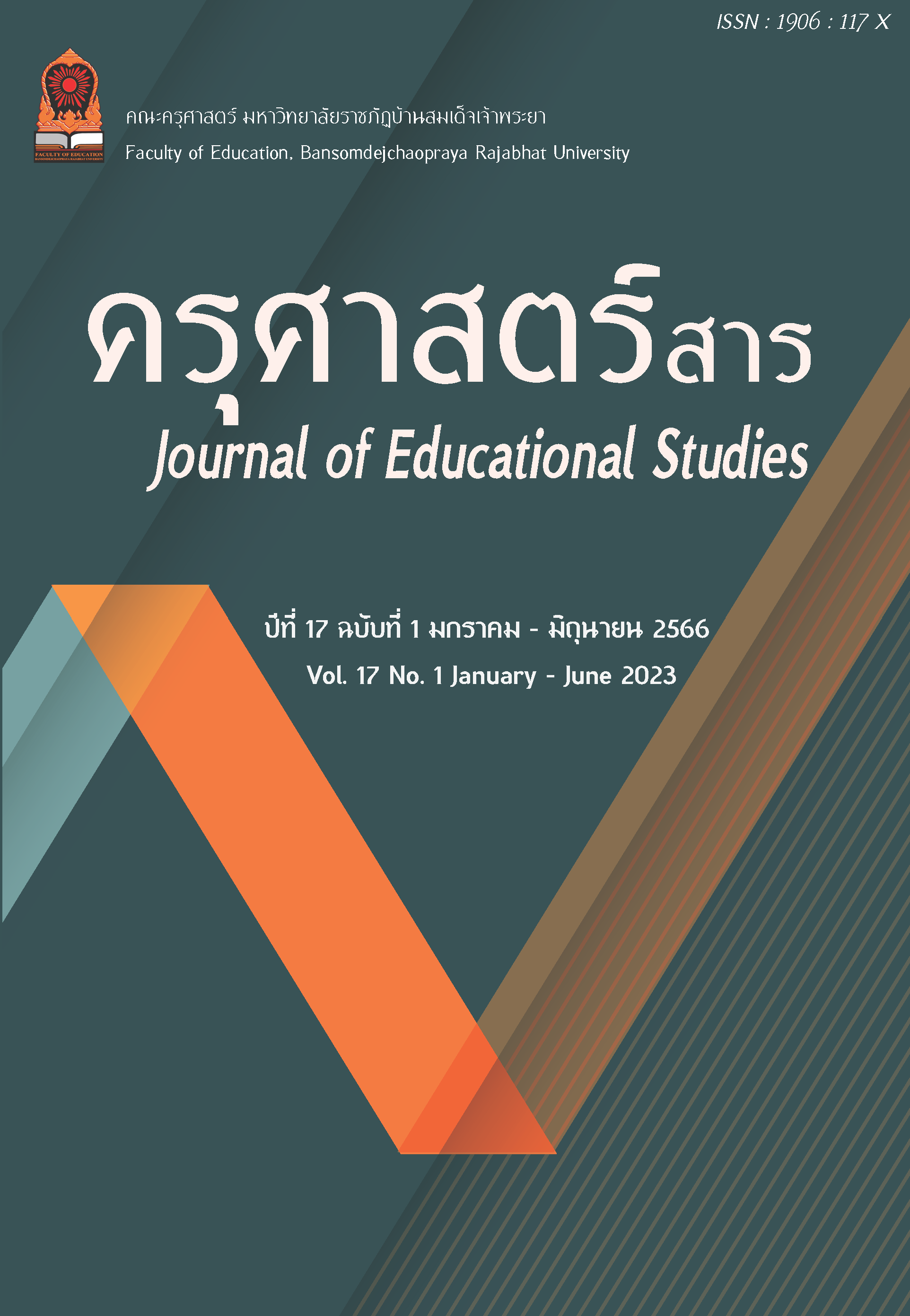Development of English Reading Comprehension Skills of Grade 11 Students at Wat Pradoonaisongtham School through Active Learning Approach Integrated with SQ4R technique
Keywords:
English Reading Comprehension, Active Learning Approach, SQ4R TechniqueAbstract
The purposes of this pre-experimental research were 1) to compare English reading comprehension skills between before and after learning through active learning approach integrated with SQ4R technique and 2) to examine relative development of English reading comprehension skills of high school students at Wat Pradoonaisongtham School after learning through active learning approach integrated with SQ4R technique. The samples included 30 Matthayomsuksa 5/2 students from Wat Pradoonaisongtham School obtained by classroom unit-based cluster random sampling. Experimental instrument involved 4 lesson plans based on active learning approach integrated with SQ4R technique and data were collected using pretest and posttest, and were statistically analyzed by percentage, MEAN, standard deviation, paired sample t-test, and relative development scores. The findings revealed the following.
1) The samples’ English reading comprehension skills after learning through
active learning approach integrated with SQ4R technique were significantly higher at .05 level.
2) The samples’ relative development scores after learning through active learning approach integrated with SQ4R technique measured averagely 59.72%, which was at high level.
Downloads
References
จีราภรณ์ ขำมณี. (2562). การพัฒนาความสามารถการอ่านจับใจความและการเขียนสรุปความด้วยกิจกรรมการเรียนรู้แบบ SQ4R ของนักเรียนชั้นประถมศึกษาปีที่ 4-6 (วิทยานิพนธ์ปริญญามหาบัณฑิต). มหาสารคาม. มหาวิทยาลัยมหาสารคาม. สืบค้นจากhttps://shorturl.asia/yvWim
ตะวัน รุ่งแสง และ เมษา นวลศรี. (2564). การพัฒนาความความสามารถในการคิดแก้ปัญหาของนักเรียนชั้นมัธยมศึกษาปีที่ 3 โดยใช้การจัดการเรียนรู้แบบสตอรี่ไลน์ เรื่อง ระบบนิเวศ. Journal of Roi Kaensarn Academi. ปีที่ 6 ฉบับที่ 7. (กรกฎาคม 2564): 47-61.
ประไพ เอกอุ่น. (2542). การศึกษาไทย. กรุงเทพมหานคร: สำนักพิมพ์สถาบันราชภัฏสวนสุนันทา.พระราชบัญญัติการศึกษาแห่งชาติ พ.ศ. 2542 และแก้ไขเพิ่มเติม (ฉบับที่ 2) พ.ศ.2545. (14 สิงหาคม 2542). ราชกิจจานุเบกษา. เล่มที่ 2 ตอนที่ 4, หน้า 13-17.
รัตนภัณฑ์ เลิศคำฟู. (2547). การใช้วิธีการสอนแบบเอสคิวโฟร์อาร์ ในการสอนอ่านจับใจความสำคัญสำหรับนักเรียนชั้นประถมศึกษาปีที่ 5. มหาวิทยาลัยเชียงใหม่/เชียงใหม่.DOI: https://doi.nrct.go.th/ListDoi/listDetail?Resolve_DOI=10.14457/CMU.the.2004.466
ศิริชัย กาญจนวาสี. (2552). ทฤษฎีการทดสอบแบบดั้งเดิม. (พิมพครั้งที่ 6). กรุงเทพฯ: สำนักพิมพ์จุฬาลงกรณมหาวิทยาลัย.
สุทัศน์ ภูมิภาค. (2562). ภาษาอังกฤษกับสังคมไทยในปัจจุบัน. สืบค้น 20 พฤศจิกายน 2565, จาก https://rb.gy/3jbpyj
สุนทร อุตมหาราช. (2547). “การเปรียบเทียบความเข้าใจในการอ่านและความสนใจในการเรียนภาษาอังกฤษของนักเรียนชั้นมัธยมศึกษาปีที่ 3 ที่ได้รับการสอนโดยวิธีสอนแบบ SQ4R กับการสอนตามคู่มือครู.” วิทยานิพนธ์ปริญญาครุศาสตรมหาบัณฑิต สาขาหลักสูตรและการสอนบัณฑิตวิทยาลัย มหาวิทยาลัยราชภัฏกำแพงเพชร.
สุนันทา มั่นเศรษฐวิทย์. (2545). เทคนิควิจัยด้านการอ่าน. พิมพ์ครั้งที่ 3. กรุงเทพมหานคร: สำนักพิมพ์มหาวิทยาลัยเกษตรศาสตร์.
สุพัตรา มูลละออง. (2558). การพัฒนาแบบฝึกเสริมทักษะการอ่านเพื่อความเข้าใจโดยใช้การอ่านกลวิธี แบบร่วมมือและเทคนิคแผนผังกราฟิก สำหรับนักเรียนชั้นมัธยมศึกษาปีที่ 3 โรงเรียนสระยาย โสมวิทยา อำเภออู่ทอง จังหวัดสุพรรณบุรี. วารสารวิชาการ, 8(2). สืบค้นจาก https://rb.gy/qgd51b
สำนักงานคณะกรรมการการศึกษาขั้นพื้นฐาน. (2554). เพื่อนคู่คิด มิตรคู่ครู แนวทางการจัดการเรียนรู้. กรุงเทพมหานคร: โรงพิมพ์ชุมนุมสหกรณ์การเกษตรแห่งประเทศไทย.
อดิศยา ปรางทอง. (2560). การพัฒนากิจกรรมการอ่านภาษาอังกฤษเพื่อความเข้าใจโดยใช้เทคนิค SQ4R เรื่อง ปัญหาวัยรุ่น สำหรับนักเรียนชั้นประถมศึกษาปีที่ 6 (วิทยานิพนธ์ปริญญา มหาบัณฑิต). พิษณุโลก. มหาวิทยาลัยนเรศวร. สืบค้นจาก https://shorturl.asia/tWoLJ
Arikunto, S. (1986). Dasar-Dasar Evaluasi Pendidikan. Jakarta: Bumi Aksara.
Brookfield, S.D. (2005). Discussion as the way of teaching: Tools and techniques for democratic classrooms (2nded). San Francisco: Jossey-Bass.
Drake, S. M. (2000). Integrated curriculum: A chapter in the Curriculum Handbook. Alexandria, VA: ASCD.
Hair, J. F., Black, W. C., Babin, B. J., Anderson, R. E., & Tatham, R. L. (2006). Multivariate data analysis (Vol. 6). Upper Saddle River, NJ: Pearson Prentice Hall.
Hartati, N., & Yogi, H. P. S. (2019). Item Analysis for a Better Quality Test. English Language in Focus (ELIF), 2(1), 59–70.
Kline, R. B. (2005). Principles and practice of structural equation modeling (2nd ed.). New York, NY: Guilford Press.
Lindlof, T.R., & Taylor, B.C. (2002). Qualitative Communication Research Methods, 2nd Edition. Thousand Oaks, CA: Sage.
Meyers, C., & Jones, T. B. (1993). Promoting Active Learning: Strategies for the College Classroom. San Francisco, CA: Jossey-Bass Inc.
Nachmais, C. F. & Nachmais, D. (2008). Research methods in the Social Sciences: Seventh Edition. New York, NY: Worth Publishers.
Robinson, F. P. (1961). Effective study. New York: Harper & Brothers.
Downloads
Published
How to Cite
Issue
Section
License

This work is licensed under a Creative Commons Attribution-NonCommercial-NoDerivatives 4.0 International License.
บทความที่ได้รับการตีพิมพ์เป็นลิขสิทธิ์ของคณะครุศาสตร์ มหาวิทยาลัยราชภัฏบ้านสมเด็จเจ้าพระยา
ข้อความที่ปรากฏในบทความแต่ละเรื่องในวารสารวิชาการเล่มนี้เป็นความคิดเห็นส่วนตัวของผู้เขียนแต่ละท่านไม่เกี่ยวข้องกับมหาวิทยาลัยราชภัฏบ้านสมเด็จเจ้าพระยา และคณาจารย์ท่านอื่นๆในมหาวิทยาลัยฯ แต่อย่างใด ความรับผิดชอบองค์ประกอบทั้งหมดของบทความแต่ละเรื่องเป็นของผู้เขียนแต่ละท่าน หากมีความผิดพลาดใดๆ ผู้เขียนแต่ละท่านจะรับผิดชอบบทความของตนเอง



